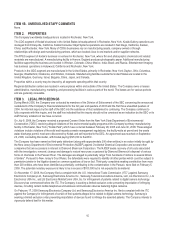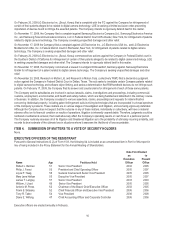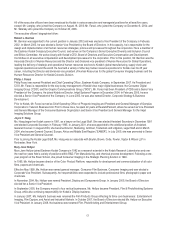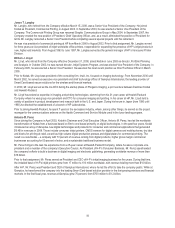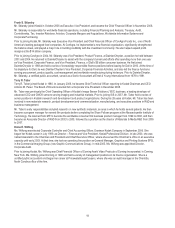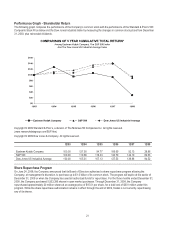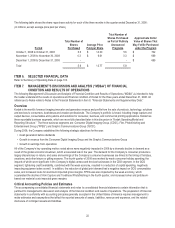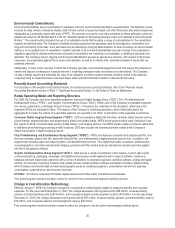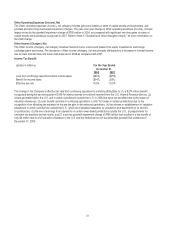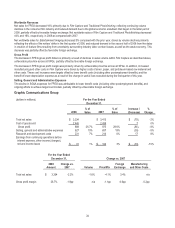Kodak 2008 Annual Report Download - page 26
Download and view the complete annual report
Please find page 26 of the 2008 Kodak annual report below. You can navigate through the pages in the report by either clicking on the pages listed below, or by using the keyword search tool below to find specific information within the annual report.24
The fair values of reporting units within the Company’s CDG and FPEG segments, and one of the two GCG reporting units were
greater than their respective carrying values as of December 31, 2008, so no goodwill impairment was recorded for these reporting
units. Reasonable changes in the assumptions used to determine these fair values would not have resulted in goodwill impairments
in any of these reporting units.
The Company’s long-lived assets, other than goodwill and indefinite-lived intangible assets, are evaluated for impairment whenever
events or changes in circumstances indicate the carrying value may not be recoverable. When evaluating long-lived assets for
impairment, the Company compares the carrying value of an asset group to its estimated undiscounted future cash flows. An
impairment is indicated if the estimated future cash flows are less than the carrying value of the asset group. The impairment is the
excess of the carrying value over the fair value of the long-lived asset group.
Due to continued operating losses and increased uncertainty of future cash flows because of the economic environment in the fourth
quarter of 2008, the Company evaluated the long-lived assets of FPEG’s Paper and Output Systems business and GCG’s
Electrophotographic Solutions business for impairment. No impairment loss was recorded related to either business as a result of
this evaluation.
Income Taxes
The Company accounts for income taxes in accordance with SFAS No. 109, "Accounting for Income Taxes" and Financial
Accounting Standards Board (“FASB”) Interpretation No. 48 “Accounting for Uncertainty in Income Taxes” (“FIN 48”). The asset and
liability approach underlying SFAS No. 109 requires the recognition of deferred tax liabilities and assets for the expected future tax
consequences of temporary differences between the carrying amounts and tax basis of the Company’s assets and liabilities. FIN 48
prescribes a recognition threshold and measurement attribute for financial statement recognition and measurement of a tax position
taken or expected to be taken in a tax return, and also provides guidance on various related matters such as derecognition, interest
and penalties, and disclosure.
The Company records a valuation allowance to reduce its net deferred tax assets to the amount that is more likely than not to be
realized. The Company has considered forecasted earnings, future taxable income, the mix of earnings in the jurisdictions in which
the Company operates and prudent and feasible tax planning strategies in determining the need for these valuation allowances. If
Kodak were to determine that it would not be able to realize a portion of its net deferred tax assets in the future, for which there is
currently no valuation allowance, an adjustment to the net deferred tax assets would be charged to earnings in the period such
determination was made. Conversely, if the Company were to make a determination that it is more likely than not that the deferred
tax assets, for which there is currently a valuation allowance, would be realized, the related valuation allowance would be reduced
and a benefit to earnings would be recorded.
The Company’s effective tax rate considers the impact of undistributed earnings of subsidiary companies outside of the U.S.
Deferred taxes have not been provided for the potential remittance of such undistributed earnings, as it is the Company’s policy to
indefinitely reinvest its retained earnings. However, from time to time and to the extent that the Company can repatriate overseas
earnings on essentially a tax-free basis, the Company's foreign subsidiaries will pay dividends to the U.S. Material changes in the
Company’s working capital and long-term investment requirements could impact the decisions made by management with respect to
the level and source of future remittances and, as a result, the Company’s effective tax rate.
The Company operates within multiple taxing jurisdictions worldwide and is subject to audit in these jurisdictions. These audits can
involve complex issues, which may require an extended period of time for resolution. Although management believes that adequate
provisions have been made for such issues, there is the possibility that the ultimate resolution of such issues could have an adverse
effect on the earnings of the Company. Conversely, if these issues are resolved favorably in the future, the related provisions would
be reduced, thus having a positive impact on earnings.
Pension and Other Postretirement Benefits
Kodak’s defined benefit pension and other postretirement benefit costs and obligations are dependent on the Company's key
assumptions. These assumptions, which are reviewed at least annually by the Company, include the discount rate, long-term
expected rate of return on plan assets (“EROA”), salary growth, healthcare cost trend rate and other economic and demographic
factors. Actual results that differ from our assumptions are recorded as unrecognized gains and losses and are amortized to
earnings over the estimated future service period of the active participants in the plan or, if almost all of a plan’s participants are
inactive, the average remaining lifetime expectancy of inactive participants, to the extent such total net unrecognized gains and
losses exceed 10% of the greater of the plan's projected benefit obligation or the calculated value of plan assets. Significant
differences in actual experience or significant changes in future assumptions would affect the Company’s pension and other
postretirement benefit costs and obligations.
The EROA assumption is based on a combination of formal asset and liability studies that include forward-looking return
expectations, given the current asset allocation. The EROA, once set, is applied to the calculated value of plan assets in the
determination of the expected return component of the Company’s pension income or expense.
SFAS No. 87, “Employers’ Accounting for Pensions” (“FAS 87”) requires that expected return be calculated using either fair value of



